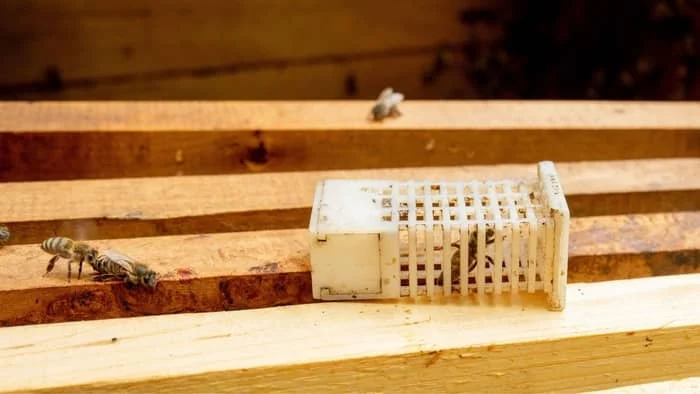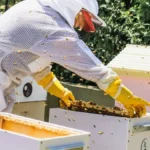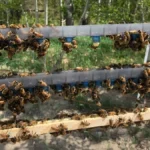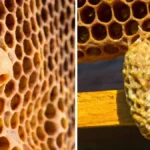We take a look at how many splits can be made from one hive. Naturally, there are a lot of factors that affect the number of splits. If you do it right, making splits is a quick, easy process. Knowing when to split a beehive helps you control swarms. This article takes us on a scenic tour that helps us shine some light on this splitting topic.
How Many Splits Can Be Made From One Hive?
This is a bit of a strange question! It is like asking how many pieces of string can you cut from a piece of string. The important thing is to create a few boundaries to this question.
In my experience splits that are made with at least five frames of brood and pollen perform the best. These frames must be covered in a good layer of bees and the top of the frames must be covered when you place the lid on the hive. In this regard, the more bees in a hive, the more splits you can technically make.
Walkaway Splits
Hence if you have a strong hive that is in two brood boxes, you should be able to make four splits into five-frame nucleus boxes. You can then place queen cells or caged queens in the queenless hives. Alternatively, you can just let the bees rear their own queens in so-called walk-away splits.
A walkaway split is a simple easy, low-time method. You literally just split the brood box or boxs up into the splits. The only thing you need to check is that every box has freshly laid eggs in it. Then you literally walk away and let the bees make their own new queens.
How Long Does It Take To Do A Split?
This will depend on how methodical you wish to be. If you want to make a quick walk away split it is really just a case of putting a few nucleus boxes on the ground next to the hive. You open the hive and just remove frames and glance at them to make sure you get some eggs in each nucleus box. Often we are making splits in spring and it is still a bit cold. The quicker you work, the happier the splits.
I normally keep an old plastic tub with me. I just use a half-gallon ice cream tub. When you have finished the splits, use the tub to scrape up the extra bees in the mother hive box and dump them into the splits.
If you use this method it will literally take you about twenty minutes maximum from removing the lid until you have split a two brood box hive into four nucleus hives.
More Time-Consuming Splits
If it is a bit warmer, you may wish to find the queen bee. Put her in one nucleus box, and mark that box. Place queen cells or caged queens in the other boxes. Then you can put the box that had the queen back in the original hives spot and move the three other boxes to a new apiary.

These splits take a bit more time – if you are good at finding queens not much more time. Let us say half an hour or a bit longer as you learn the ropes. With time you can get this down to twenty minutes or less as well.
The main thing that adds time is moving the splits to a new apiary. But this is well worth it and increases the success rate and the speed with which your bees adapt.
When To Split A Beehive
These are management decisions we all have to make. Splitting a hive reduces its size. A smaller hive will produce less honey. If we have a big strong hive, and we requeen it via a number of different methods, that hive will go on to produce a large crop of honey.
However, if we wish to increase our apiary size, splits provide more bees. In this case, we sacrifice a bit of honey production to produce more bees. Hence there is no direct answer to when to split a beehive. But if the hive is big and strong and full of bees and you have not requeened it you have the following choices. Requeen it, super up, and expect a big honey crop. Do nothing and lose a big swarm and get a smaller crop. Split the hive and increase your hive count and get a somewhat smaller crop.
The Benefits Of A Small Swarm Control Split
One method I have played with, and which some big beekeepers swear by, is a small single nucleus swarm control split. In this method, you build up a big production hive. When this hive looks ready to swarm, you remove the old queen and a few frames of brood into a swarm control split. Requeen the mother hive and prepare it for honey production.
The small nucleus is then removed to a new apiary and built up to be a production hive later in the year or in the next season. In this way, you hardly damage the population of the honey production hive, and you are able to simulate a small swarm. This small “swarm” then grows into a production hive for the next season.
An Extreme Case
How many splits can be made from one hive if you really push the bees? A friend of mine had a “bee factory” in California in the 1990s. He had an unlimited supply of glucose sugar waste from a few candy factories. He would dilute this, and feed his hives constantly. There was abundant year-round pollen in his area, either from agriculture or wildflowers.
His hives would bulk up very fast and he would split off deep brood boxes into two nucs every few weeks producing tens of splits per year from a single hive. The downside of this was that people who bought hives from him sometimes wondered why the frames were blue or red or green from the colorants in the candy!!
We hope this helped you understand a bit more about making splits. Splitting hives is actually one of the most rewarding activities in beekeeping. It is a bit like making cuttings of your favorite plants. When you see each new cutting root, you feel great. When you see a new split start bulking up and turn into a big beehive it is equally rewarding. Share and enjoy.
Read more about: Queen Cup Vs Queen Cell

Dr. Garth A. Cambray is a Canadian/South African entrepreneur and beekeeper with 28 years of experience in apiculture and specializes in adding value to honey. His Ph.D. research developed a new advanced continuous fermentation method for making mead that has resulted in a number of companies globally being able to access markets for mead. His company, Makana Meadery, exports honey mead to the USA where it is available to discerning connoisseurs. He has also developed technologies to commercially manufacture organic honey vinegar in Zambia for export globally. He holds a few patents globally in the ethanol industry and believes in technology and knowledge transfer for human development and environmental sustainability. One of his proudest achievements is the fact that the wind farm he started at one of his old apiary sites has essentially made his hometown carbon neutral.






